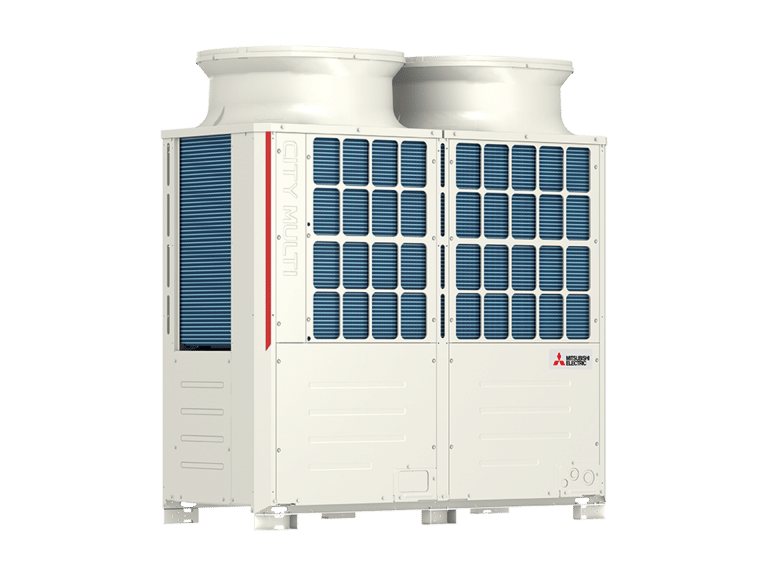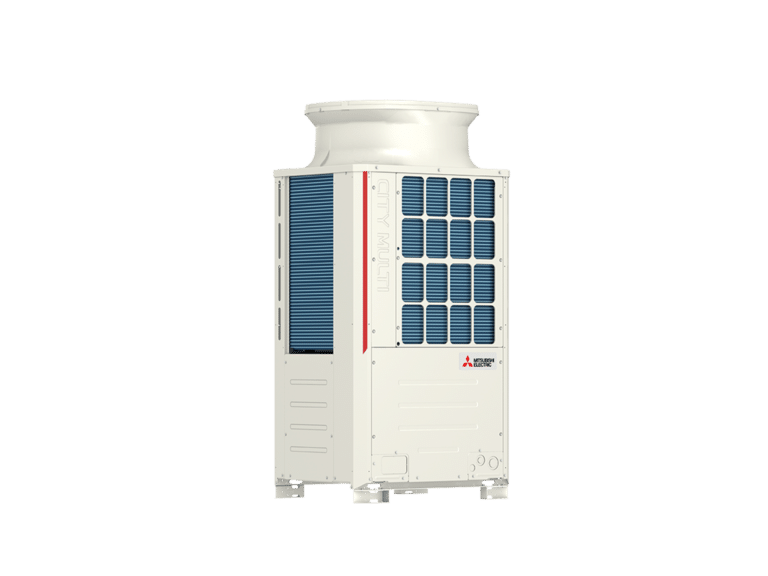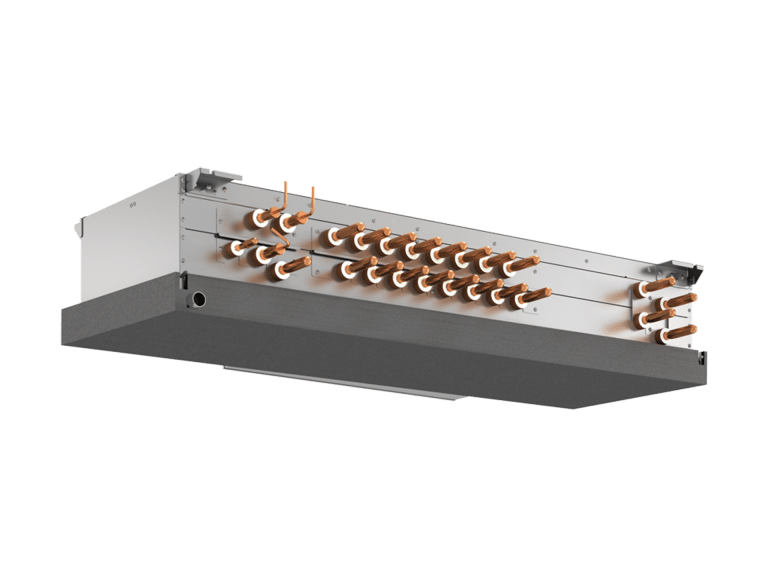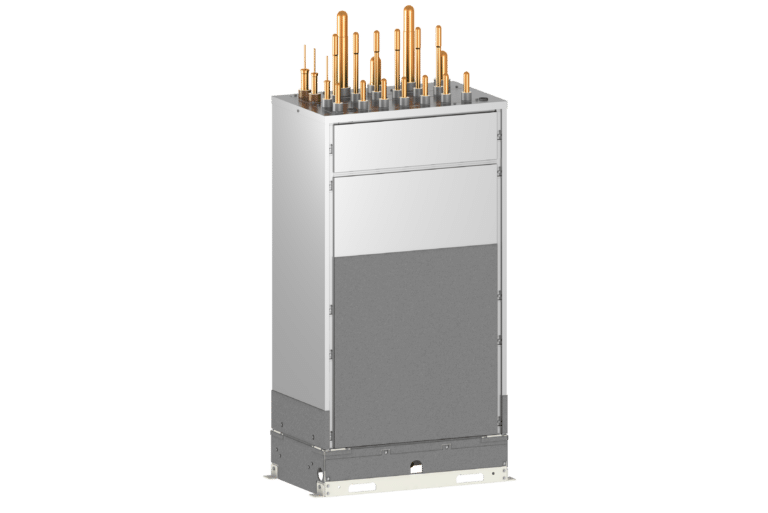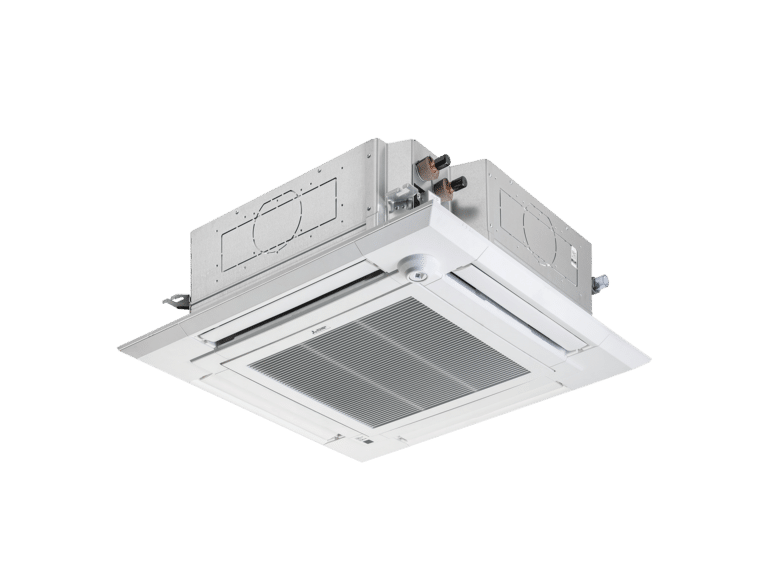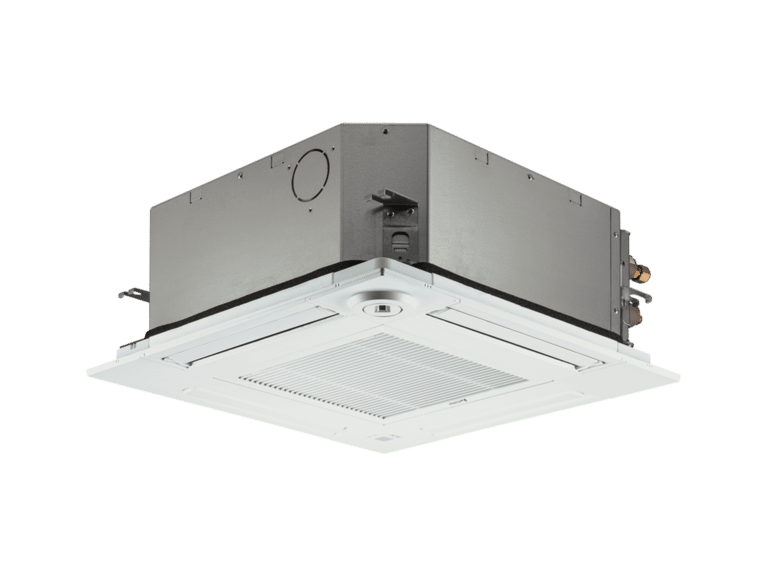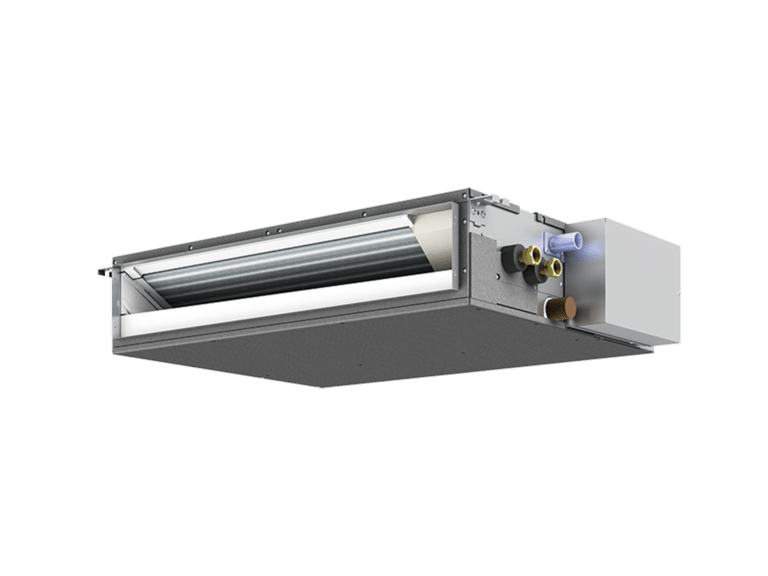How City Multi Hybrid VRF Works
The City Multi Hybrid VRF operates through a dual-circuit system controlled by the Hybrid BC Controller (HBC). The HBC serves as the system’s central component, housing:
- Refrigerant-to-water heat exchangers
- Circulation pumps
- Control valves
- System controls
This dual-circuit system involves the following processes:
Refrigerant Circuit | Outdoor Unit to HBC
Refrigerant-based heat transfer occurs between the outdoor unit and the HBC through a refrigerant-to-water energy transfer process conducted by the heat exchangers in the HBC. Outdoor units are available in two configurations:
- Air Cooled Heat Recovery models using either a R410A or R32 refrigerant
- Water-cooled models with a R410A refrigerant
Water Circuit | HBC to Indoor Units
Water circulates from the HBC to individual indoor fan coil units, with the HBC managing water flow and temperature control. This secondary circuit eliminates the refrigerant from occupied spaces while maintaining individual zone control.
System Control
Temperature management can be executed through:
- Centralised building management systems
- Individual local remote controllers
- Scheduled operation parameters
Benefits of Hybrid VRF
Enhanced safety and compliance
City Multi Hybrid’s innovative design uses water between the Hybrid BC Controller (HBC) and indoor units, eliminating refrigerant from occupied spaces. This breakthrough delivers multiple advantages:
- Ensures the health, safety and comfort of occupants
- Compliance with AS/NZS 5149 standards
- Eliminates the cost and complexity of refrigerant leak detection systems
- Simplified maintenance and reduced ongoing compliance costs
- Enhanced peace of mind for occupants and building managers
- Ideal for sensitive areas like healthcare facilities, schools, and hotels
By using water as the heat transfer medium in occupied spaces, City Multi Hybrid offers the perfect balance of performance and safety without compromising energy efficiency. This is available in Mitsubishi Electric R32 refrigerants with the option for a low Global Warming Potential (GWP) refrigerant.
Better air temperature regulation
With Hybrid VRF air conditioning, the Secondary Circuit provides naturally stable temperatures throughout the year, creating a more comfortable environment by delivering milder off-coil temperatures. This water-based approach helps maintain consistent temperature levels across different zones.
Energy Efficient Design
Mitsubishi Electric has introduced the world’s first 2-pipe heat recovery system, reducing energy consumption during simultaneous cooling and heating operations. The energy-saving benefits increase with more frequent simultaneous operation. Additional efficiency gains can be achieved through centralised control and scheduled operation features, helping to optimise system performance.
Components of the Hybrid VRF Air Conditioning System
City Multi Hybrid VRF air conditioning systems are configured with three key components: Outdoor units, HBCs, and indoor units. Explore each component with the Mitsubishi Electric range below:
Outdoor units
The City Multi R2 Series featuring R32 refrigerant combines efficient heat recovery capability through its 2-pipe refrigerant circuit with increased energy efficiency.
Benefits:
This outdoor unit supports simultaneous cooling and heating, making it ideal for commercial spaces with varying thermal needs. The unit uses heat recovery to transfer excess heat from one area to another, reducing energy use. The 2-pipe system allows continuous operation without compressor shutdown during mode changes, maintaining comfort and improving efficiency. Available in R32 refrigerant, which has a lower global warming potential, and can deliver cooling even at ambient temperatures of up to 52°C.
Features:
The PURY-M(MP)-YNW-A1(-BS) has the following features:
- 2-pipe recovery system: An advancement from the 3-pipe system, this system reduces piping and connections, simplifying installation and maintenance.
- Mild of-coil air temperatures: The efficient water system between the HBC and indoor units creates a stable water temperature year-round.
- Heat recovery for energy savings: The system recovers heat from zones in cooling mode and redirects it to areas that require heating. This reduces outdoor unit load and lowers energy use, especially in buildings with mixed zone demands. When heating and cooling occur simultaneously, such as in offices with sun-exposed rooms, interior spaces, or server rooms, the energy-saving effect is maximised.
- Maximum height difference of 90 metres: This increased distance between indoor and outdoor units ensures flexibility in where the unit can be installed.
The City Multi YNW Series is designed for applications requiring year-round cooling and heating flexibility with capacities ranging from 22.4 to 124 kW.
Benefits:
The PURY-P200-1100(EP)-YNW provides efficient heat recovery between indoor units through its 2-pipe refrigerant circuit, enabling simultaneous cooling and heating operations while maintaining a reduced footprint.
Features:
This outdoor unit is equipped with the following features:
- Static fan pressure modifiable up to 80 Pa: It be set between 0-30-60 and 80Pa, allowing you to install the unit in positions with varying ventilation requirements.
- Extended operating range up to 52℃: The unit can deliver cooling at high ambient temperatures with zero interruptions.
- Advanced “low noise” function: Quiet operation that ensures comfort for all occupants.
- Maximum height difference of up to 90 metres: The distance between this unit and indoor units has been extended to increase flexibility with installation positions.
- Simultaneous heating and cooling: Supports mixed zone needs by recovering heat between indoor units at the Hybrid BC, improving comfort and reducing energy use.
The City Multi WR2 Series uses water source heat recovery for efficient year-round comfort. With a capacity range from 22 to 150 kW, it features double heat recovery—first between indoor units, then between PQRY units via the water loop—making it suitable for high rises, colder climates, and buildings with diverse temperature zones.
Benefits:
The PQRY-P200-900Y(S)LM-A delivers high efficiency for buildings that require simultaneous cooling and heating. Ideal for properties with kitchens, offices, or equipment rooms in close proximity, it helps maintain stable indoor conditions regardless of season or layout. With a connection capacity of up to 50 indoor units and no need for an outdoor heat exchanger, it reduces rooftop requirements and supports installation across multiple floors.
Features:
As part of a commercial air conditioning system, this unit offers the following key features:
- Double heat recovery system: Enhances energy efficiency by recovering heat between indoor units and again between PQRY units via the water loop.
- Reduced plant room sizes: Because the unit does not release radiant heat, it can be installed in compact plant rooms on each floor, saving space and freeing rooftop areas for potential recreational use.
- Individual and centralised control options: Offers temperature control per indoor unit or via a central system, depending on the building’s needs.
- Simultaneous heating and cooling: Supports varying zone requirements across the building, making it suitable for offices with both shaded and sunlit rooms or hotels with year-round demand.
Hybrid Branch Controllers
CMB-WM108-1016V-AA/AB Hybrid Branch Controller(Main & Sub) – Standard Series
A core component of City Multi Hybrid VRF, this HBC manages the transition from refrigerant to water circuits and houses essential components, including heat exchangers, circulation pumps and control valves in a single integrated unit.
Benefits:
The CMB-WM108-1016V-AA/AB maintains compliance with AS/NZS 5149 regulations and removes the need for leak detection systems, reducing maintenance costs and increasing occupants’ peace of mind. Using advanced technology to simplify installation, the HBC helps reduce the amount of refrigerant in outdoor units and completely eliminates refrigerant in indoor units’ pipes.
Features:
The CMB-WM108-1016V-AA/AB includes features such as:
- Scalable installation: Its simple installation can be conducted in stages alongside the growth of occupants or building size.
- Two plate heat exchangers: Helping transfer energy from the refrigerant circuit to the indoor unit, they provide what’s needed for simultaneous heating and cooling.
- Valve block: This feature selects the heating or cooling function and controls the water flow to the indoor units, ensuring compliance with capacity requirements.
CMB-WM350/500F-AA Hybrid Branch Controller – Vertical HBC Series
Designed with flexibility as the priority, the CMB-WM350/500F-AA eliminates the need for ceiling access during commissioning. As a vertical unit, it can be installed at floor level in plant rooms, cupboards, or risers.
Benefits:
The floor-standing Vertical HBC enhances the serviceability of the Hybrid VRF system by providing front access to all key components at floor level. This HBC also ensures simple and cost-efficient installation by reducing the need for leak detection systems and offering phased installation.
Features:
This key component of Hybrid VRF commercial air conditioning systems has the following features:
- Flexible main-HBC: It can connect up to 6 ports with optional 8 or 16-port sub-HBC expansion units for larger installations.
- Better air temperature regulation: The HBC provides greater comfort for occupants by circulating water through the fan coil network.
- Valve Block: It has a dual function of selecting between heating and cooling settings and controlling the water flow to indoor units.
- Floor-standing operation: This unit provides a compact footprint that can be easily installed at floor level, whether discretely located in cupboards or plant rooms.
HVRF Indoor Units
To achieve optimum air conditioning that suits the unique demands of commercial spaces, we provide a range of commercial indoor air conditioners available in various models, sizes and capacities. Our current line-up of indoor units includes:
- Low and medium static ducted air conditioners:
- 4-way airflow ceiling cassette air conditioners
- Floor console air conditioners
- Wall-mounted air conditioners
Discover all the models available in our HVRF indoor units range today.
